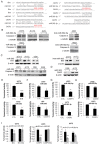Novel anti-apoptotic microRNAs 582-5p and 363 promote human glioblastoma stem cell survival via direct inhibition of caspase 3, caspase 9, and Bim
- PMID: 24805821
- PMCID: PMC4013090
- DOI: 10.1371/journal.pone.0096239
Novel anti-apoptotic microRNAs 582-5p and 363 promote human glioblastoma stem cell survival via direct inhibition of caspase 3, caspase 9, and Bim
Abstract
Glioblastoma is the most common and lethal primary brain tumor. Tumor initiation and recurrence are likely caused by a sub-population of glioblastoma stem cells, which may derive from mutated neural stem and precursor cells. Since CD133 is a stem cell marker for both normal brain and glioblastoma, and to better understand glioblastoma formation and recurrence, we looked for dys-regulated microRNAs in human CD133+ glioblastoma stem cells as opposed to CD133+ neural stem cells isolated from normal human brain. Using FACS sorting of low-passage cell samples followed by microRNA microarray analysis, we found 43 microRNAs that were dys-regulated in common in three separate CD133+ human glioblastomas compared to CD133+ normal neural stem cells. Among these were several microRNAs not previously associated with cancer. We then verified the microRNAs dys-regulated in glioblastoma using quantitative real time PCR and Taqman analysis of the original samples, as well as human GBM stem cell and established cell lines and many human specimens. We show that two candidate oncogenic microRNAs, miR-363 and miR-582-5p, can positively influence glioblastoma survival, as shown by forced expression of the microRNAs and their inhibitors followed by cell number assay, Caspase 3/7 assay, Annexin V apoptosis/fluorescence activated cell sorting, siRNA rescue of microRNA inhibitor treatment, as well as 3'UTR mutagenesis to show luciferase reporter rescue of the most successful targets. miR-582-5p and miR-363 are shown to directly target Caspase 3, Caspase 9, and Bim.
Conflict of interest statement
Figures






References
-
- Stupp R, Mason WP, van den Bent MJ, Weller M, Fisher B, et al. (2005) Radiotherapy plus concomitant and adjuvant temozolomide for glioblastoma. N Engl J Med 352: 987–996. - PubMed
-
- CBTRUS (2010) CBTRUS Statistical Report: Primary Brain and Central Nervous System Tumors Diagnosed in the US 2004–2006.
-
- Maher EA, Furnari FB, Bachoo RM, Rowitch DH, Louis DN, et al. (2001) Malignant glioma: genetics and biology of a grave matter. Genes Dev 15: 1311–1333. - PubMed
-
- Hegi ME, Diserens AC, Gorlia T, Hamou MF, de Tribolet N, et al. (2005) MGMT gene silencing and benefit from temozolomide in glioblastoma. N Engl J Med 352: 997–1003. - PubMed
Publication types
MeSH terms
Substances
Grants and funding
LinkOut - more resources
Full Text Sources
Other Literature Sources
Molecular Biology Databases
Research Materials

